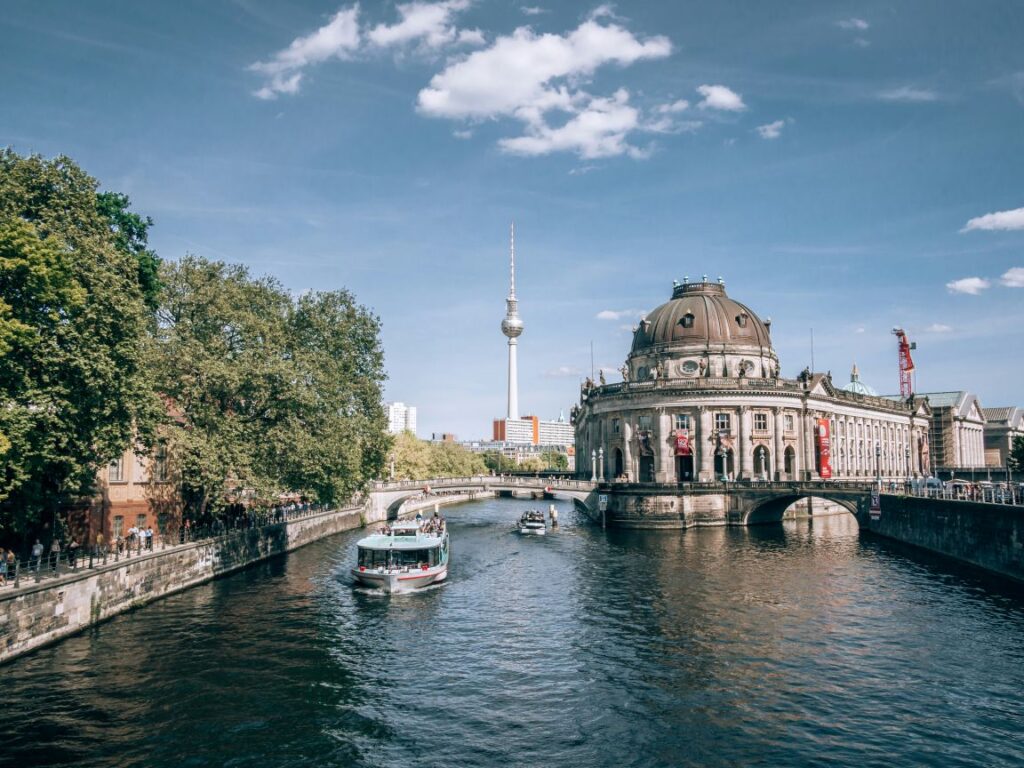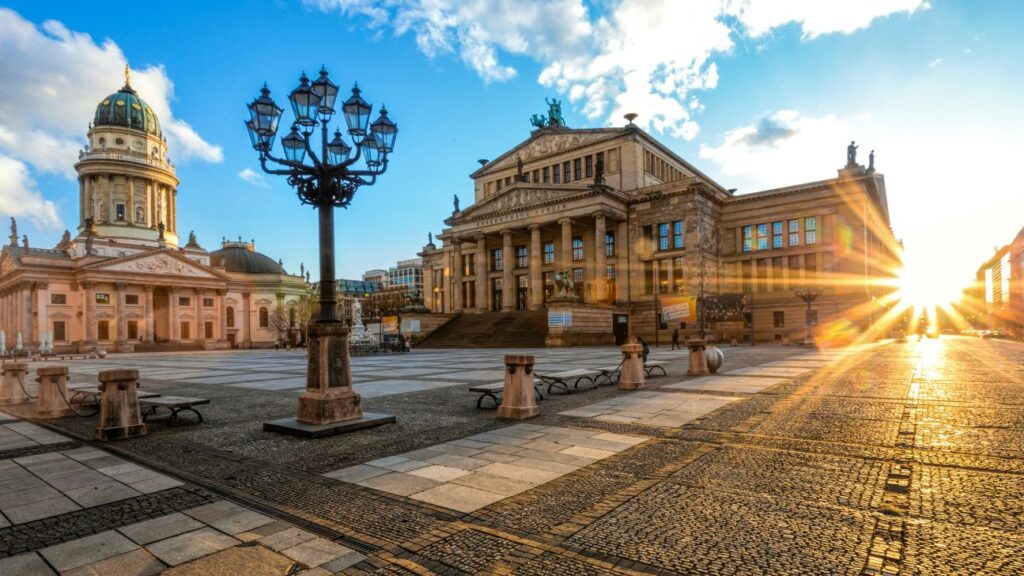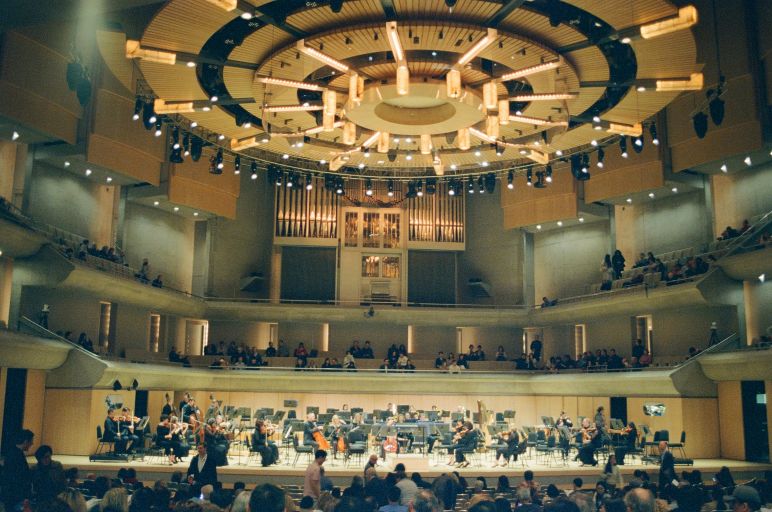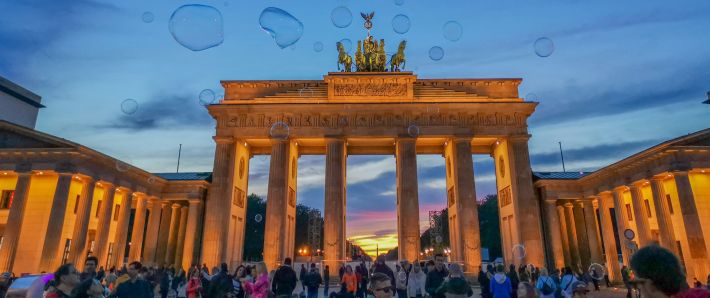Why Berlin Is Perfect for a Relaxed Historical Trip
Berlin isn’t a quiet city, but it rewards those who slow down. A Berlin historical tour offers more than big monuments and facts. It gives you the chance to walk through the stories that shaped the modern world.
The city blends old and new. Around one corner, you’ll see a palace from the 1700s. Around another, a glass dome where lawmakers debate today’s policies. You don’t have to rush. This is a place where culture and history meet in a way that feels human.
Berlin is also easy to enjoy at your own pace. English is widely spoken. Public transportation is simple. Many top sites are walkable. That makes it ideal for couples who want meaning, not mayhem.
Berlin has layers of history you can still feel. You don’t need to squint to imagine the past—it’s right in front of you. From the cobblestones to the scars on buildings, this city invites you to walk and notice.
That’s why it’s so well suited for a thoughtful couple’s trip. It doesn’t force you into a fast pace. You can take your time. You can explore neighborhoods that still carry their 19th-century layouts, or sip wine beside a Cold War-era structure without needing to join a tour group.
Unlike cities where the past feels staged, Berlin just is. That honesty makes it easier to connect. You’re not just watching history—you’re walking through it.

When to Take a Berlin Historical Tour
Some cities feel too busy or too cold depending on the season. Berlin doesn’t. It offers something in every month. But for a historical tour, the best times to visit are late spring or early fall.
May, June, September, and early October offer pleasant weather. You’ll avoid extreme heat and large tour groups. Fall in Berlin is calm, and you’ll see golden trees lining cobblestone streets.
Time your trip with cultural events to get more from your Berlin historical tour. Long Night of Museums (in August) lets you visit many top museums late into the night. Christmas markets open in late November, which adds a different kind of history — traditions you can experience instead of just read about.
To make the most of the season, choose a few days that fall mid-week. Museums are less crowded, and the rhythm of the city feels gentler.
Each season in Berlin brings a different lens to your historical tour. Spring feels hopeful. New leaves fill the Tiergarten, and cafés reopen their outdoor seating. You’ll see locals easing back into the city’s rhythm after a long winter.
Summer is lively but still manageable. In June and July, the sun stays up late. This gives you time for early evening walks after dinner—ideal for seeing illuminated sites without large groups.
If you visit in winter, don’t write it off as a loss. The Christmas markets offer warmth, history, and local charm. Museums stay open, and it’s a great time to visit if you like quiet galleries and cozy meals.
Where to Stay for Comfort, Charm, and Access
Choosing the right hotel can make or break your Berlin historical tour. Berlin is big, but it doesn’t have to feel that way. Stay in a central location and everything becomes easier.
Look in the Mitte district. This is where many major sites are found. You’ll be close to Museum Island, Brandenburg Gate, and the Reichstag. The vibe is relaxed but never dull. For luxury with history, try Hotel Adlon Kempinski. It sits near the Brandenburg Gate and blends old-world charm with modern comfort.
If you want something more intimate, consider Orania.Berlin. It’s in Kreuzberg, a creative district with roots in Berlin’s divided past. The hotel has its own jazz nights and high-end restaurant, yet it never feels fussy.
Gorki Apartments offers another take: a stylish, private space in a restored 19th-century building. This option works well for travelers who like hotel service but want a quiet base to return to after a full day of exploring.
Your hotel doesn’t need to be flashy. It needs to be central, comfortable, and connected to Berlin’s story.
Think beyond luxury chains. Berlin rewards travelers who choose places that reflect the city. For example, The Mandala Hotel near Potsdamer Platz combines minimal design with great spa services. It’s quiet, clean, and puts you near both history and culture.
Another strong choice is Wilmina. It’s a hotel built into a former courthouse and women’s prison, redesigned into a serene and stylish place. It feels rooted in Berlin’s story without being heavy or overdone.
Check hotel reviews carefully—not for stars, but for neighborhood feel. A great stay isn’t just about the room. It’s about how you feel when you come back to it after a long day exploring.
Day-by-Day Itinerary for a Relaxed Berlin Historical Tour

A Berlin historical tour doesn’t need to be packed with back-to-back stops. Here’s a five-day plan that lets you move at a steady pace, with room to enjoy the city. You don’t need to over-plan to enjoy Berlin. But having a loose structure gives your trip a rhythm. This itinerary isn’t packed to the hour. Instead, it leaves room for you to sit, think, and explore a little deeper.
The goal isn’t to visit every single museum. It’s to have a clear sense of Berlin’s past and present, and how the city invites you to engage with both.
Each day includes one or two core activities. You can build around them with meals, short detours, or quiet time back at your hotel.
Day 1: Arrival and a Walk Through Berlin’s Past
Start with an easy walk through the heart of the city. Stay close to your hotel and stretch your legs along Unter den Linden. This tree-lined street takes you past historic buildings, statues, and cafés.
Stop by Bebelplatz, the site of the Nazi book burnings in 1933. The memorial here is subtle but powerful. From there, walk to Gendarmenmarkt, one of Berlin’s most elegant squares. Sit with a glass of wine and take in the architecture.
End your day with dinner at Zur Letzten Instanz. It’s Berlin’s oldest restaurant and has served guests since the 1600s, including Napoleon. The setting is casual but full of character.
If you still have energy after dinner, take a slow walk near the Reichstag. The building is lit at night, and the area is open, with plenty of space to enjoy the view.
On your way back, stop at a wine bar or café that catches your eye. Even late in the evening, Berlin feels safe and open. It’s a gentle way to ease into your Berlin historical tour.
Day 2: Museum Island and Berlin Cathedral
Start the day on Museum Island. You could spend a full week here, but one day is enough for highlights. The Pergamon Museum holds some of the most impressive archaeological finds in Europe. The Neues Museum shows pieces from Egypt, including the famous bust of Nefertiti.
Take a quiet moment at the Berlin Cathedral nearby. You can climb to the dome for a view, or stay on the ground level and listen to the organ.
Have lunch along the Spree River, then head back to your hotel to rest before dinner. For the evening, book a table at a restaurant with a view — the rooftop at Hotel de Rome is a calm spot to end the day.
Before you go, explore other cultural journeys like this one in Stockholm’s hidden neighborhoods. Each city adds something different to your travel story.
Consider booking a timed ticket for the Pergamon Museum. This avoids the crowds and lets you focus. Early morning or late afternoon slots tend to be quietest.
If you’re not up for climbing the cathedral dome, sit in the courtyard nearby. You’ll still get a view of Berlin’s skyline, framed by old and new buildings.
For a different kind of evening, visit Clärchens Ballhaus. It’s a historic ballroom and restaurant where locals go to dance, dine, and watch performances. It’s casual, fun, and deeply Berlin.
Day 3: Berlin Historical Tour Through War and Division
This day focuses on Berlin’s 20th-century history. It’s sobering but necessary. Begin at the Topography of Terror, the site of the former SS and Gestapo headquarters. The outdoor panels and underground museum are free to visit and very well presented.
Walk to Checkpoint Charlie and the nearby museum. While it’s touristy, the exhibits tell real stories of escape and division. Then head to the Berlin Wall Memorial on Bernauer Strasse. This is the most complete and respectful place to learn what the Wall meant to the people living here.
After a break, book a guided Cold War tour or visit the DDR Museum. It’s interactive, so you’ll get a feel for daily life in East Germany. End your evening at Käfer on the rooftop of the Reichstag. It’s one of the few restaurants inside a working parliament building and feels like a fitting close to the day.
Before you head to the Wall Memorial, consider a detour through Mauerpark. On weekends, it hosts a large flea market and public karaoke. It’s a light way to contrast the heavy history you’ll be seeing later.
When at the Wall, take time with the outdoor exhibits. They don’t just show timelines—they highlight individual lives, escapes, and losses. It’s sobering, but unforgettable.
To close the day, walk slowly back along the Spree River. Berlin’s lights reflect off the water, and the walk gives you space to process everything you’ve seen.
How to Enjoy a Berlin Historical Tour in Comfort and Style
Walking is the best way to see Berlin. But not every walk has to be long or crowded. One way to make your Berlin historical tour more pleasant is to use a private guide. Many companies offer tours led by historians or local experts.
You can also book early access to museums before the crowds arrive. Or hire a driver for longer routes, like trips out to Potsdam or Sachsenhausen.
If you prefer independence, the Berlin WelcomeCard helps with free transport and discounted entry to many sites. But don’t feel like you have to rush. It’s okay to pick just one or two things each day and give yourself time to enjoy them.
Berlin rewards curiosity. But it also gives you room to breathe. Tour companies like Context Travel or Original Berlin Walks are well-regarded for small group and private tours. Their guides often have academic backgrounds or personal connections to Berlin’s history.
If you don’t want to commit to a tour every day, try just one—maybe a Cold War or Jewish heritage tour. You’ll gain context that helps you appreciate what you see later on your own.
Wear comfortable shoes. Many historic areas have uneven stones or long walking paths. Bring layers too. Even in warmer months, Berlin mornings and nights can be cool.
Dining That Connects You to Berlin’s Past

Dining in Berlin can be casual or high-end, but many of the best places add historical flavor. Some restaurants sit in old post offices, train stations, or even former embassies. You’re not just eating — you’re stepping into a story.
For a classic experience, try Lutter & Wegner near Gendarmenmarkt. It’s been around since the 1800s and serves German food with polish. The candlelight and wood-paneled rooms feel timeless. Ask for a table by the window for people-watching in the square.
If you’re looking for something modern with history, book a table at Rutz. The building survived the war, and the menu is now one of the best in Berlin. Expect seasonal ingredients, clean lines, and a calm vibe. You don’t need to dress up, but the food and service will impress.
Want something more relaxed? Look for places that serve East German dishes or Cold War-era menus. Some food tours even focus on this theme. It’s a fun, low-key way to connect with your Berlin historical tour.
Markthalle Neun in Kreuzberg is a historic food hall that combines Berlin’s past and present. It’s a great stop for lunch or a snack. On Thursdays, they host Street Food Thursday, offering dishes from around the world.
If you’re interested in local traditions, book a cooking class with a small group. Some focus on old Berlin recipes like Königsberger Klopse or Sauerbraten. You get a hands-on feel for the culture—not just the flavors.
Don’t skip the bakeries. Many are family-run and have been around for generations. A slice of Apfelstrudel in a quiet café can be just as meaningful as a fine dining experience.
Day Trips That Extend Your Berlin Historical Tour
If you’re staying more than four days, consider a few short trips. These places are close but add another layer to your Berlin historical tour.
Potsdam is just 45 minutes away. It’s home to Sanssouci Palace, wide gardens, and quiet lakes. The palaces here were once used by Prussian kings. Today, they offer a slower look at life behind power. You can book a guide or explore at your own pace.
For those interested in World War II history, Sachsenhausen is a former concentration camp site about an hour from Berlin. It’s somber and deeply moving. Many couples choose to visit with a guide to better understand what happened there. This isn’t a casual day trip, but it is an important one.
Want something different? The Liebermann Villa near Lake Wannsee combines art, history, and nature. Max Liebermann was a German-Jewish painter, and his home gives insight into Berlin’s pre-war creative world. This location often gets overlooked, but it’s peaceful and full of meaning.
To get a sense of the area before visiting, Germany’s official travel site offers helpful background and seasonal travel tips.
If you’re visiting Sanssouci Palace, plan to spend a few hours in the gardens. They’re large and peaceful, with fountains and shaded paths perfect for walking.
Lunch in Potsdam can be easygoing. Try a spot near the Dutch Quarter, where red brick buildings create a cozy atmosphere. Many restaurants offer traditional German meals with a light, modern twist.
Returning to Berlin in the late afternoon gives you time to rest and reflect. You don’t need to fill every minute. Let the day settle in.
Add-On Cultural Experiences for Deeper Travel

If you’re the kind of traveler who likes more than monuments, Berlin has plenty to offer. A Berlin historical tour doesn’t have to stop at museums. You can add music, art, and even books to the experience.
Try catching a performance at the Berlin State Opera or the Konzerthaus. Many historic venues offer short, early evening concerts — perfect if you want something enriching that doesn’t last too long.
Berlin also has strong gallery scenes in both Mitte and Kreuzberg. Many of them sit in restored buildings or repurposed industrial sites. You can combine art and architecture in one visit.
Not sure where to start? Add one cultural stop each day. A gallery walk. A cooking class. A film screening. These little touches help round out your Berlin historical tour and keep each day interesting.
Berlin has many independent bookshops with curated English sections. Places like Shakespeare and Sons or Dussmann offer fiction, memoirs, and history that can deepen your understanding of the city.
You might find a live jazz night or open-air film screening. Both are common in summer and often take place in historic courtyards or parks.
If you’re interested in a specific topic—architecture, resistance movements, or Cold War politics—look up small museums or walking tours that focus just on that. Berlin is full of specialists.
Wrapping Up Your Berlin Historical Tour
After five thoughtful days, you’ll leave with more than pictures. A Berlin historical tour gives you context — for Europe, for the modern world, and for the people who shaped it.
What makes Berlin special is how much of it feels human. The monuments are impressive, but the moments in between matter just as much. A quiet coffee after seeing the Wall. A long lunch in a 200-year-old inn. A view from a cathedral dome.
It’s not just about what you see. It’s about how you see it.
If you enjoy culture-rich travel, you might enjoy exploring Kyoto’s heritage sites or tracing classical history through the backstreets of Thessaloniki. Each place reveals something new when you slow down.
Some trips fade over time. Others stay with you. A Berlin historical tour tends to do the latter.
It stays not because of the grand buildings, but because of the small things. The quiet sidewalk plaque. The café that was once a meeting place. The museum guide who still remembers what the Wall felt like.
You don’t need to see everything to feel something. A few thoughtful stops can carry more meaning than a packed schedule. This is what Berlin offers when you give it time.


Leave a Reply